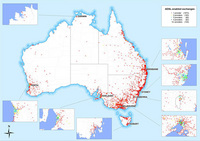Is your broadband better than average?

Ever wondered if your ISP's coverage is exactly what they promised? The government has released its latest state of the nation report into Australia's broadband -- and consumers can see exactly what they're getting.
The report released jointly by the ACCC and the ACMA has taken a snapshot of how Australia's mobile, fixed line, broadband and broadcast TV has fared over the last year or so.
According to the report, the number of ISPs with their own DSLAMs has risen in the long term, with 19 now boasting their own kit, compared to the nine in the 2004-2005 report. However, the number shows no increase from the 2005-2006 when the same 19 joined the unbundlers.
"ISPs have begun rolling out their own DSLAM infrastructure rather than reselling Telstra Wholesale's broadband services, which have restrictions on service offerings, pricing and bandwidth delivery. Some ISPs claim cost benefits from installing their own DSLAM infrastructure, because it allows greater control over costs and potentially higher earning margins per customer. Network deployments may also lead to additional revenue streams through provision of wholesale services to other ISPs," the report said.
The study has found that 91 percent of the population now have access to some form of ADSL connectivity from 2,432 exchanges. Aside from Telstra, the biggest ADSL rollouts are, in descending order, iiNet, Optus, PowerTel, Primus and TPG.
ADSL2+, capable of up to 24Mbps downlink, is now available in 17 percent of DSL-enabled exchanges, up from 14 percent in June 2006, and 57 percent of metropolitan exchanges, increased from 53 percent last June. Most of the growth in ADSL2+ services has emerged in non-metropolitan areas, according to the report.
That's not to say those in the bush or remoter areas are enjoying burgeoning connectivity. "Infrastructure competition is predominantly based in the capital cities of Adelaide, Brisbane, Canberra, Melbourne, Perth and Sydney. While most exchanges are served by only one infrastructure provider, this report identifies 459 exchanges served by more than one infrastructure provider, with many consumers having access to two or more infrastructure providers," the report notes.
Australia's total Internet population has grown to around 6.4 million users, 761,000 of whom are business and government subscribers -- and many of whom are battling with low speed connections. The study reveals that 33 percent of government and business users are on connections slower than 256kbps, 21 percent are between 256kbps and 512kbps, 512kbps to 1.5Mbps makes up 25 percent of business connections with the remaining 21 percent boasting speeds of 1.5Mbps or greater.
Nevertheless, speeds are increasing slowly across the country. Internet connections with download speeds of 1.5Mbps or greater increased to 1.56 million as of March 2007, compared to 1.09 million subscribers at the end of September 2006.
According to the report, as of June 2006, there were 1.6 million 3G users in Australia, from a total mobile population of 19.7 million. The number of third generation users is expected to increase dramatically -- Telstra is planning to close its 2G CDMA network from next January.
The various reports can be found at the ACMA Web site.
